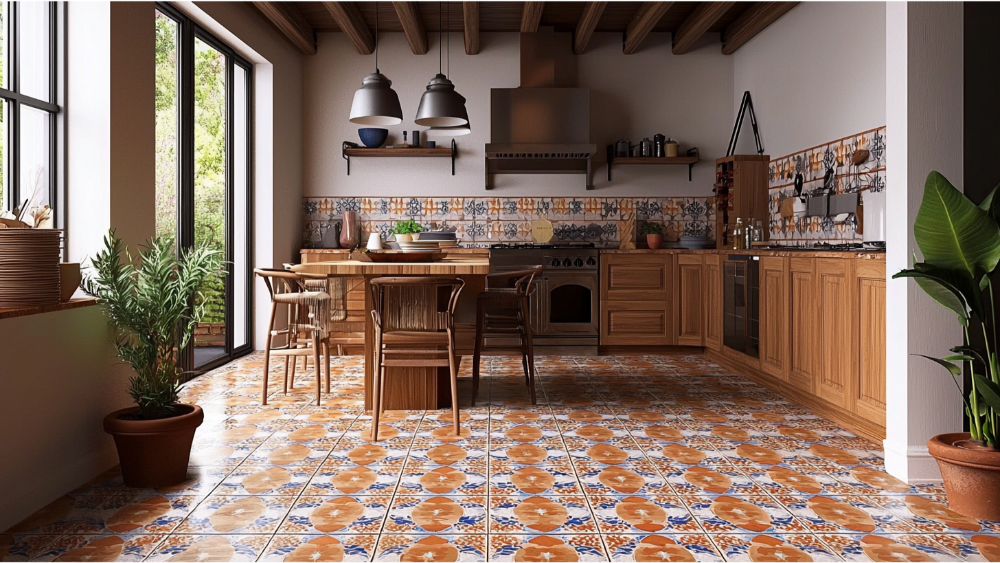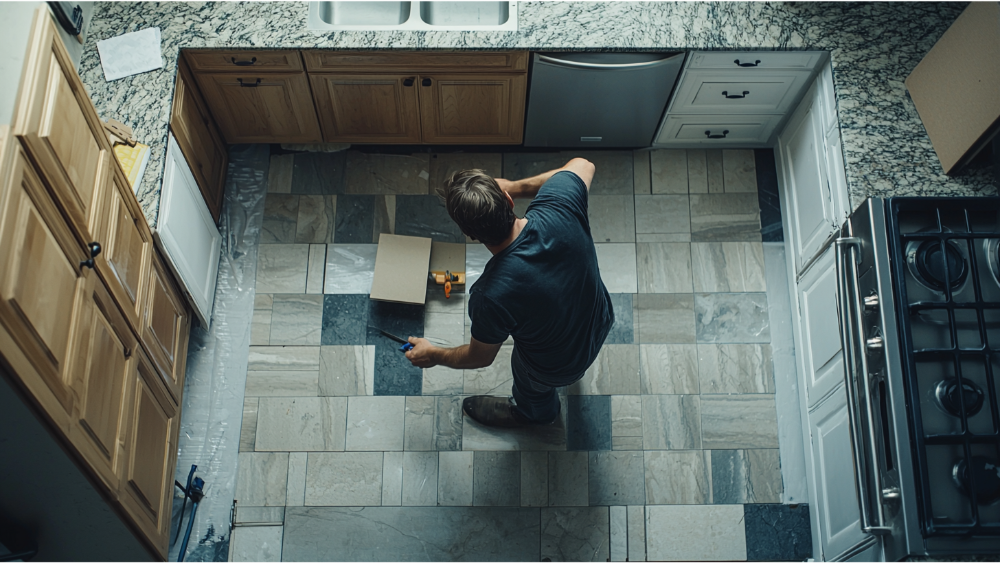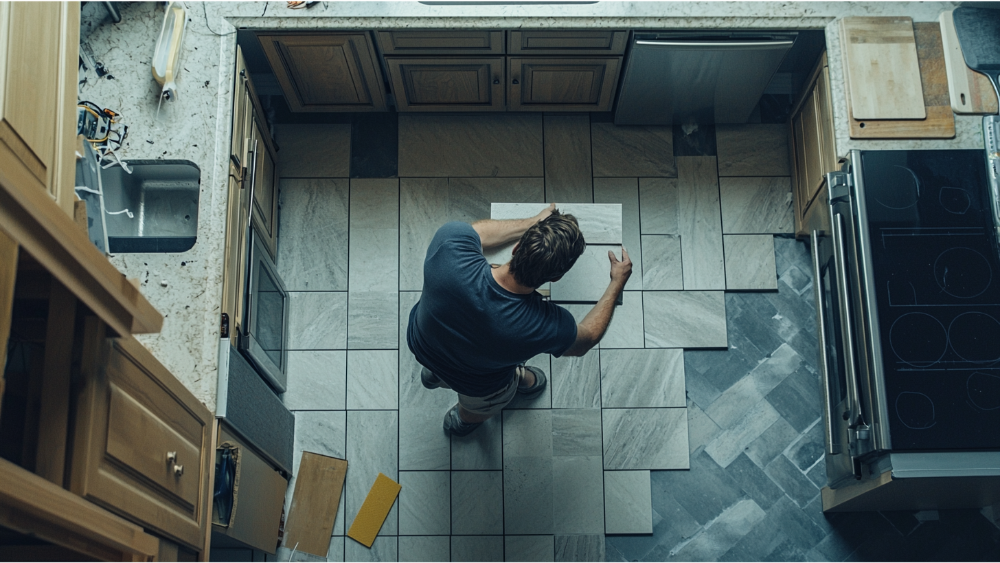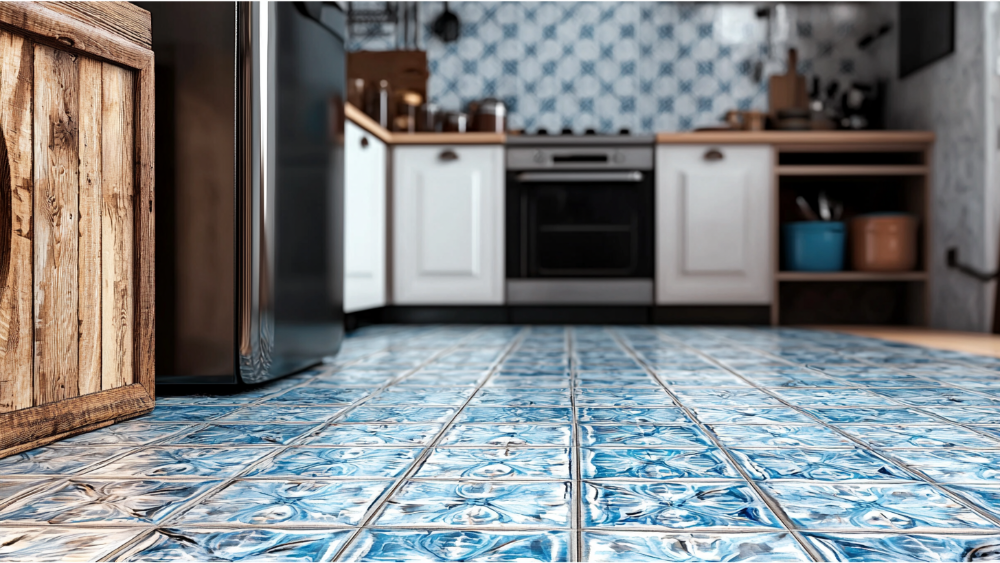
When renovating a kitchen, one important decision involves the timing of installing tile in relation to the cabinets. This choice can impact the overall look and functionality of the space, as well as the installation process. Understanding the pros and cons of each approach can help ensure the best outcome for your kitchen project.
Installing Tile Before Kitchen Cabinets
Pros:
Uniform Look
Installing the tile floor underneath the cabinets results in a seamless, uniform appearance throughout the kitchen, with no noticeable gaps or transitions. This method creates a polished, professional look that enhances the finished floor. It also ensures that the flooring remains consistent no matter how your layout or cabinet arrangement changes over time. A uniform floor can also help increase the resale value of your home by giving it a more cohesive aesthetic.
Flexibility for Renovations
With the tile underneath the cabinets, future renovations are easier. You can replace floor cabinets without worrying about matching or patching the ceramic tile. This added flexibility can save time and money in the long run, as you won’t need to redo the floor during a cabinet update. It also allows for easier adjustments if you ever decide to rearrange the layout of your kitchen.
Watertight Seal
Placing the tile floor first offers better protection against spills and water damage. The tile installation creates a barrier that prevents water from seeping into the subfloor. This is especially important in kitchens, where water and spills are common. A properly sealed floor reduces the risk of mold growth and structural damage, making it a more durable and long-lasting solution.
Cons:
Higher Costs
Installing the ceramic tile under the cabinets requires more materials and labor, as the tile floor will cover areas that are not visible. This increases the upfront cost of the project. While this investment adds flexibility and durability, it may not be necessary if you’re certain the cabinets will remain in place long-term. Homeowners working within a tight budget might find the additional expense difficult to justify.
Time-Intensive
Laying tile underneath the floor cabinets before you install cabinets takes more time, which could delay the overall renovation timeline. This extra step requires careful planning and coordination to ensure the cabinets fit perfectly afterward. For those on a tight schedule, this approach may not be ideal, as it can significantly extend the duration of the project.
Installing Tile After Kitchen Cabinets

Pros:
Cost-Effective
Tiling only the exposed areas of the kitchen floor reduces material and labor costs, making this method a more budget-friendly option. By focusing on visible areas, you save on purchasing unnecessary tiles and can allocate your budget to other aspects of the renovation. This approach is ideal for those working within tight financial constraints.
Reduced Risk of Damage
Installing the ceramic tile after the floor cabinets minimizes the chance of damaging the tile floor during the cabinet installation process. This is especially helpful on busy renovation sites. Heavy cabinetry or movement of tools during installation can chip or crack tiles, so avoiding tiling beneath cabinets adds an extra layer of protection. It also reduces the likelihood of needing to replace damaged tiles later.
Efficient Installation
Since there’s less area to cover, the tile installation process is faster when you avoid tiling beneath the cabinets. This saves valuable time for contractors and homeowners alike, allowing renovations to be completed more quickly. It also means less disruption in your home, which is particularly beneficial if you’re living in the space during the renovation.
Cons:
Uneven Transitions
This method might create slight height differences between the tile floor and the floor cabinets, resulting in less visual consistency on the finished floor. These transitions can sometimes be noticeable in areas like exposed cabinet edges or kickboards. Over time, this unevenness might also affect how certain appliances or furniture sit on the floor.
Limited Renovation Options
If you remove or replace the floor cabinets in the future, untiled areas may be exposed, requiring patchwork or additional tile installation to match the rest of the floor. Matching older tiles with new ones can be challenging if the original design or material is no longer available. This limitation might lead to extra costs and delays during future renovations.
Final Recommendation
Installing the tile floor before the kitchen cabinets is the better choice for most projects. While it requires more materials and upfront costs, the benefits include a clean, uniform finished floor and easier future renovations. The tile underneath the cabinets ensures that the ceramic tile installation is watertight and visually seamless. For a long-term solution that prioritizes durability and aesthetics, tiling before installing cabinets is the ideal approach.
Factors to Consider for Tiling BEFORE Kitchen Cabinets
Material Type
When installing porcelain tile under the base cabinets, ensure it is durable enough to withstand the weight of the cabinetry. Porcelain tile is a long-lasting and resilient choice that can handle heavy loads without cracking. It’s also important to select a consistent style and color since the tile will cover the entire floor, even under unseen areas. Consider whether a concrete slab or cement board underlayment is required to provide additional structural support. Proper preparation ensures a level surface for tile install, extending the longevity of the entire floor.
Installation Process
Laying tile before installing new cabinets requires precise measurements to ensure cabinetry fits perfectly over the tiled surface. The tile install should account for adjustments due to expansion and contraction, which are especially critical when working with materials like porcelain tile. Using a proper backer board or cement board can help stabilize the tiles and prevent issues like cracking over time. During installation, pay attention to creating a seamless, watertight surface to protect the subfloor from spills. It’s a longer process, but one that guarantees a flawless finish.
Future Renovations
Tiling the entire floor before placing base cabinets provides flexibility for future remodeling. If you decide to replace or move cabinets later, the consistent flooring won’t require patchwork or matching outdated porcelain tiles. This is particularly important if the existing tile design or size is discontinued in the future. Renovating over a complete tile surface ensures a smooth process without additional expenses. For long-term convenience, investing in a full-floor tile install is worthwhile.
Factors to Consider for Tiling AFTER Kitchen Cabinets

Budget Constraints
If you’re managing a tight renovation budget, tiling only the visible areas of the kitchen floor is more economical. This approach reduces the cost of materials, as you won’t need to purchase tiles for areas hidden under base cabinets. Homeowners can also save on labor costs, as the tile install area is smaller and requires less time to complete. Choosing this method allows you to allocate funds to other upgrades, such as higher-end new cabinets or countertops. It’s a practical way to achieve a functional kitchen without exceeding your financial limits.
Risk of Damage
Avoiding tiling under the base cabinets reduces the chance of damaging porcelain tiles during their installation. Heavy tools, movement of cabinets, and other equipment can easily chip or crack tiles, leading to additional repairs or replacements. By focusing on tiled areas that are not under cabinets, you lower the risk of costly mishaps during renovations. Consider using protective coverings for tiled areas as further reinforcement if other work is ongoing in the kitchen. An efficient approach here can keep the entire floor in pristine condition.
Appearance and Consistency
Tiling after cabinets can lead to minor differences in the floor’s height or alignment. Situations such as uneven transitions between the tile and surrounding surfaces may detract from the seamless look of the room. If you opt for this method, careful planning is needed to avoid noticeable gaps or edges around base cabinets and kickboards. Additionally, limited tiling may make the floor appear less cohesive if future modifications expose untiled areas. Ensure the porcelain tile design complements the visible layout for a polished appearance in the finished kitchen.
Frequently Asked Should You Install Tile After or Before Kitchen Cabinets Questions

Is it Better to Install Tile Before Cabinets?
Installing tile before cabinets is generally the preferred method for most kitchen renovation projects. This approach ensures a seamless and uniform flooring appearance, as the tile will extend throughout the entire space, including under the cabinets. Such a layout not only enhances the overall aesthetic but also prevents the need for future patchwork if you decide to update or relocate cabinets later on. Furthermore, tiling before cabinet installation creates a watertight barrier, reducing the risk of damage to the subfloor from spills or leaks.
While tiling before cabinets may require more materials and labor, leading to higher upfront costs, it also adds value by providing flexibility for future renovations. This method eliminates the challenges of matching old tiles when replacements are needed and ensures that appliances and furniture sit evenly on the new floor. If you’re planning to find cabinets for your remodel, this approach ensures a polished and long-lasting look. For long-term durability, functionality, and a polished finish, installing tile before cabinets is a wise investment for any kitchen remodeling project.
Should You Install Backsplash Before or After Cabinets?
The decision to install backsplash before or after cabinets largely depends on factors such as whether you’re planning to replace the cabinets, your personal preference, and the overall design timeline. Installing the backsplash before cabinets allows for a more cohesive and seamless look, as the backsplash can extend entirely up to the wall without interruptions. This method works best if you’re starting from scratch or completely replacing the cabinets during a remodel. It also helps create a clean, continuous aesthetic that complements the entire kitchen design.
On the other hand, some homeowners prefer to install the backsplash after the cabinets are in place. This approach gives you greater precision in aligning the backsplash with the cabinetry layout and reduces the likelihood of unnecessary material waste. If you’re keeping your existing cabinets and only updating the backsplash, this order simplifies the process and allows for customization around the current layout. Ultimately, the right choice depends on your project scope and personal preference, ensuring the end result aligns with your vision for the space.
Do You Tile Under the Dishwasher?
Whether or not to tile under the dishwasher depends on your kitchen layout and renovation goals. Tiling under the dishwasher provides a consistent flooring height and ensures that the appliance can be easily slid in and out for installation, maintenance, or replacement. This approach is particularly beneficial when combined with tiling under the toe kick and base cabs, as it creates a uniform and level surface for all kitchen components.
However, if you’re working with a tight budget or want to minimize the use of tiles, you can choose to stop tiling at the base cabinet line, just in front of the dishwasher. Keep in mind that this could lead to issues with adjusting the appliance’s height or removing it in the future, especially if the untiled section is lower than the surrounding floor. For a clean and functional design, ensure that the tiled edge near the dishwasher is properly aligned with the toe kick for a polished finish.
Conclusion
Deciding whether to tile before or after installing kitchen cabinets involves careful consideration of your renovation goals, budget, and desired aesthetic. While tiling before cabinets provides a seamless and durable finish that accommodates future changes, tiling after cabinets can reduce costs and installation time. Each method has its own advantages, from achieving a polished, cohesive look to preventing unnecessary material usage. The right approach depends on your specific needs and long-term plans for the space. By understanding the pros and cons of each option and planning accordingly, you can create a functional and visually appealing kitchen that aligns with your vision and priorities.
CONTACT US
Our Services
Areas We Serve
Certificate






